
Istria is the largest peninsula within the Adriatic Sea. The peninsula is located at the head of the Adriatic between the Gulf of Trieste and the Kvarner Gulf. It is shared by three countries: Croatia, Slovenia, and Italy, with 90% of surface area being part of Croatia. Croatia encapsulates most of the Istrian peninsula within Istria County.

Istria County is the westernmost county of Croatia which includes the biggest part of the Istrian peninsula.

Pazin is a town in western Croatia, the administrative seat of Istria County. It is known for the medieval Pazin Castle, the former residence of the Istrian margraves.
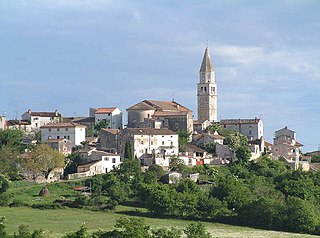
Višnjan is a village and municipality in Istria, Croatia. Višnjan is the site of Višnjan Observatory. The observatory is home of several long-running international summer programs for youth in astronomy, archeology, marine biology and other disciplines.

Cerovlje is a village and a municipality in Istria, Croatia.

Gračišće is a village and municipality of Istria County in Croatia.
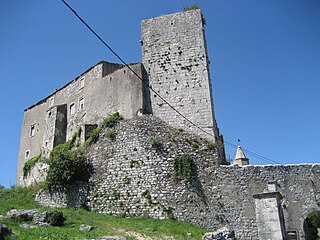
Kršan is a village and municipality in the eastern part of Istria County, Croatia.

Istria is the largest peninsula in the Adriatic Sea. The peninsula is located at the head of the Adriatic between the Gulf of Trieste and the Bay of Kvarner. It is shared by three countries: Croatia, Slovenia, and Italy.

Pietrapelosa is a castle in the Croatian part of Istria, now ruined. In the medieval period a family took their name from the castle. "Pietrapelosa" comes from the Italian words meaning "hairy stone" after the moss that has always grown on the walls of the castle. It is one of the best-preserved of the Istrian castles.

Labinština is the geographical and historical name of the eastern part of Istria county in Croatia. It covers an area of approximately 220 km2 that is 25 km long and 13 km wide. Geographical borders in the west are the Raša river, and the bay of the same name, in the south and east the sea, and in the north Plomin Bay, the southern part of the Učka massif and Kvarner Bay, and, until the beginning of the 20th century, Lake Čepić. The center is Labin after which it is named. Labin was the head township of the Labinština or Agro Albonese under the Roman Empire, during the Venice Republic between 1365 and 1797, the Austrian rule between 1814-1918 and many other occupations by foreign armies.

Šušnjevica is a small village in Istria County, Croatia, in the municipality of Kršan. The village is inhabited mostly by Istro-Romanians.
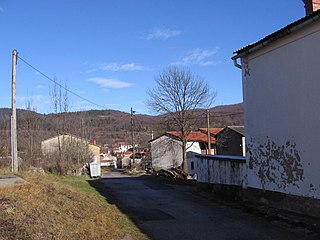
Žejane is a village in the eastern part of mountainous Ćićarija area in Istria, Croatia. Administratively it belongs to the municipality of Matulji in Primorje-Gorski Kotar County. In 2011, the population of Žejane was 130.

Kožljak is a village in Istria County, Croatia, in the municipality of Kršan. The settlement besides of the village consists of nearby homonymous medieval ruinous castle.
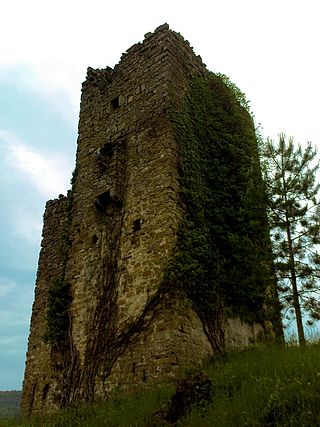
Posert Castle, also known as Šabec (Schabez) and St. Martin, is a ruined fortress near the road between Paz and Šušnjevica, in municipality of Cerovlje, in Istria, Croatia. The ruins of the castle depending on the name are dating back to the 11th century, or 16th century (Šabec), while by archeological evidence to the second half of the 14th century. The castle was vastly devastated in the Uskok War (1615–17). Between 2009 and 2014 the castle was restored. Nearby the castle there is also a small Church of St. Martin from 1367.
Belaj is a small village and Baroque Castle in Istria County, Croatia, in the municipality of Cerovlje. Castle Belaj is a registered Historical Heritage. Castle Belaj historically has numerous hectares of vineyard. In 2017 Belaj Castle opens to the public. In 2011, the population of the village is 16. In the vicinity of the village is another castle Posert.
Polje Čepić or Čepić, is a village in Istria County, Croatia, in the municipality of Kršan.

Šumber is a village and ruinous castle in the eastern part of Istria County, Croatia, in the municipality of Sveta Nedelja.

The Pazin Castle is a medieval fortification built on a solid rock situated in the middle of the town of Pazin, the administrative seat of Istria County, Croatia. It is the largest and best-preserved castle in that westernmost Croatian county.
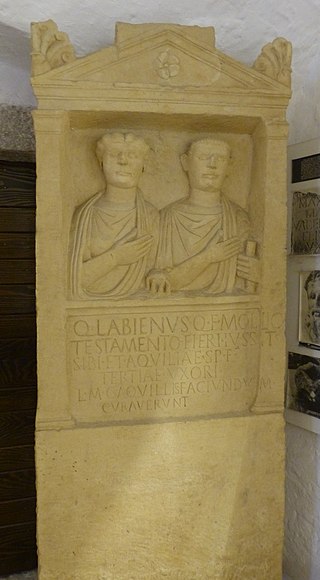
Gologorica, historically known as Moncalvo di Pisino, is a village in central Istria, near Pazin (Pisino).

Beram is a small village located in the Croatian county of Istria. It is part of the municipality of Pazin and is situated approximately five kilometres (3.1 mi) northwest of the town, on the road to Poreč. The village has a population of about 250 inhabitants. It is well-known for its Biblia pauperum and the Danse Macabre fresco in the Church of Maria im Fels.






















